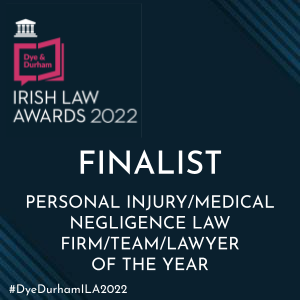SPINAL INJURY* CLAIMS
If you have suffered from a spinal injury, you can contact our team of spinal injury solicitors to advise you if you might have a case against a negligent party. You pursue a case for damages where another person or party was at fault or partly at fault for the injury. This might arise where the injury was caused by an accident, assault, or as a result of medical negligence.
WHY INSTRUCT A SPECIALIST SPINAL INJURY* SOLICITOR?
Expertise
Spinal injuries are very different to back injuries. If a person with a spinal injury is contemplating obtaining legal advice, it is strongly recommended that they seek that advice from a specialist spinal injury solicitor. The solicitor needs to have the expertise and relevant professional and medical contacts to secure all the necessary expert reports. This will achieve the best possible outcome for the individual with the spinal cord injury and their family.
A solicitor who regularly deals with spinal injury* litigation will know that each case is unique and may require a multitude of expert reports. They will have the skills and contacts required to ensure that all bases have been covered. McMahon Goldrick have worked with the leading experts you may rely on for years. They have developed a strong rapport with them, which is crucial for engaging them in a case.
Understanding
An in-depth understanding of the nature of spinal cord injuries is vital for any solicitor acting in this type of case. They need to understand how they occur and the impact that they have on individuals and families. Specialist spinal injury solicitors will have that level of knowledge and understanding which is particularly important for the case to succeed.
Rapport
A person with a spinal cord injury should have a strong relationship and rapport with their solicitor. They must trust that the solicitor understands the injury and should be confident that the solicitor has the expertise to put together a strong case. The individual should feel that the solicitor has the empathy required to understand and acknowledge the major adjustments their client has made. This is something that an experienced spinal injury solicitor can offer.
IMMEDIATE STEPS TO TAKE
1. Speak to a solicitor
If you are over 18 years old, you only have 2 years less 1 day to lodge a claim from the date of incurring your injury (there are some limited exceptions to this rule). Therefore, you should quickly make contact with a solicitor who can then advise you whether or not you might have a claim.
If the claimant is a child, then a parent or guardian can issue proceedings at any time up until the child’s 18th birthday. Thereafter, the young adult has 2 years less 1 day to bring a spinal injury claim in their own right.
2. Make a note of the incident
If you can, you should write down all the details that you can recall in respect of when and how the injury occurred. This can be a particularly difficult exercise to do after experiencing such a traumatic event, but it will be of tremendous benefit to your potential new solicitors. It will assist them with the process of taking your formal instructions. A loved one can help with this exercise.
You should make a note of the following:
- What you were doing on the day of the accident or injury,
- The timing of those activities,
- How the accident occurred,
- Who you were with,
- What medical services you immediately received etc.
The sooner you write down those details the better.
3. Obtain your medical records
Another step you can take to possibly speed up the early stages of the investigation is to obtain all of your medical records, radiology and reports from the hospitals you attended. Information on how to obtain those records will be available on the hospital’s website. It is also advisable to take up a copy of the medical records held by your GP.
HOW TO BRING A SPINAL INJURY CLAIM
Read more to see the legal steps that are involved in bringing a catastrophic spinal injury claim.
Contact Us
Looking for help? Call us on 01 6770044 or email us at info@rmcm.ie
WHAT IS A SPINAL CORD INJURY*?
The spinal cord is made up of a thick bundle of nerves that runs from the brain to the base of the spine, carrying messages and controlling vital functions such as breathing, bladder, bowel and sexual function.When the spinal cord is damaged resulting in a spinal cord injury, these messages are interrupted and functions are impaired, resulting in loss or reduced mobility, control or sensation.
Causes
- Car accidents
- Falls
- Workplace accidents
- Sports injuries
- Infection or disease
- Medical negligence
Levels of Injury
The extent of the impairment experienced by a person with a spinal cord injury depends on the level at which the injury occurs.
The loss of movement and sensation will vary from person to person, even amongst those who have damaged their spinal cord in the same place. The higher up the spinal cord the damage occurs, the more movement and sensation will be lost.
Damage to the spinal cord in the thoracic and lumbar regions of the back results in paraplegia, which affects movement and sensation in the legs and possibly some stomach muscles.
Damage to the spinal cord in the cervical region of the neck results in tetraplegia, which affects movement and sensation in all four limbs as well as some stomach and chest muscles.
Complete v Incomplete
The injury can be classified as complete or incomplete.
If both sides of the body are affected and there is no muscle function, voluntary movement or sensation from the injury level and below, then the injury is complete.
If some sensation or muscle function below the injury level remains, the injury is referred to as incomplete.
Spinal Injuries Ireland
“Mahon Goldrick Solicitors, Dublin are endorsed by Spinal Injuries Ireland to act on behalf of its members and also represents the Organisation itself. I worked with Ralph for 22 years and it was a pleasure to do so. He has acted for Spinal Injuries Ireland and its members since 1993. He has acted as an advisor to the Board, been a member of the Fundraising Committee and also the Transitional Housing Programme Committee. Integrity and professionalism are assured and it is these qualities combined with his experience and indeed that of his Partner Jessica Goldrick that gave me total comfort when referring members to him. They go about their work with a total empathy for the member and of course this is also of crucial importance. I cannot recommend Ralph and Jessica highly enough.”
Colm Whooley Former, CEO, Spinal Injuries Ireland
![]()
1. Instruct a solicitor:
You should soon get in touch a specialist solicitor who will take your instructions (details of the accident/injury, medical details, details of the alleged person or party at fault etc.). They will then advise if it might be worthwhile pursuing a claim for compensation.
It is important to note that an adult claimant only has 2 years less 1 day from the date of injury to issue proceedings in court (there are some limited exceptions to this).
When claiming on behalf of a child, a parent or guardian can issue proceedings at any time up until the child’s 18th birthday. Thereafter, the young adult has two years to bring a birth injury claim in their own right.
2. PIAB assessment:
For most claims, you are required to lodge a Personal Injuries Assessment Board (PIAB) application before the matter may be dealt with by the courts. This is not required for medical negligence claims or psychological injury claims. Many people avail of the services of a solicitor to prepare their PIAB application.
PIAB is an independent state body who assess personal injury claims outside of the court room. They determine the amount of compensation that that should be provided (if any). If either of the parties disagree with the level of compensation, then PIAB will release the claim and compensation can then be pursued through the court system.
Typically in the case of a catastrophic injury, PIAB would automatically release the claim to be dealt with by the court system, as it is too complicated a matter for them to assess.
3. Liability & causation report(s):
Your solicitor will obtain at least one expert report to establish whether the injury arose as a result of another person’s or party’s negligence.
The speciality of the expert(s) will depend on how the injury arose e.g. if it was a personal injury, such as a road traffic accident, that expert may be a forensic engineer, or if the injury arose as a result of potential medical negligence case, the expert would be a medical doctor.
4. Issue court proceedings:
Once your solicitors have obtained a supportive liability and causation report, they can issue court proceedings after the claim has been released by PIAB.
Proceedings for catastrophic spinal injury claims are typically issued in the High Court.
More information:
See here for more information on how a spinal cord injury claim injury is made.
Very generally, a catastrophic spinal cord injury claim may take in the region of 3 years to resolve, however, this is dependent on the complexity of the injury itself and how the injury arose.
It is important to note that an adult claimant only has 2 years less 1 day from the date of injury to issue proceedings in court (there are some limited exceptions to this).
When claiming on behalf of a child, a parent or guardian can issue proceedings at any time up until the child’s 18th birthday. Thereafter, the young adult has two years to bring a birth injury claim in their own right.
There are some time limits that are applied when processing some parts of the claim.
Broad Claim Timeframes
Initial Investigation:
Unknown timeframe.
Personal Injuries Board Assessment (PIAB):
1 to 9 months.
In the case of a catastrophic injury, PIAB would typically release the application so that the matter to be dealt with by the courts from the outset, as it is too complex a claim for them to assess. Also, a PIAB assessment is not needed in medical negligence or psychological injury claims
Accept or Reject Injuries Board Assessment:
28 days
Statute of Limitations:
2 years less 1 day from the date of injury for the claimant to issue proceedings in court.
Legal Proceedings:
Unknown timeframe.
More Information
See here for more information on how long a spinal cord injury claim takes in Ireland.
Your compensation will generally comprise of General Damages and Special Damages. After obtaining the appropriate quantum expert reports, your solicitors & counsel will be able to advise on the value of your claim.
General Damages
This is compensation for the pain, suffering and inconvenience you experienced and will continue to experience as a result of your injury.
The gravity of the injuries will be considered when assessing the level of general damages to be awarded.
Special Damages
This is compensation for the financial costs and expenses, both past and future, you incurred as a result of your injury.
In the case of sustaining a catastrophic injury, the special damages will make up the bulk of your claim for compensation.
Special damages include medical costs (past & future), loss of earnings and future loss of earnings, past and future nursing care and home help, the cost of housing adaptions, the purchase of specialist equipment, additional expenses etc.



